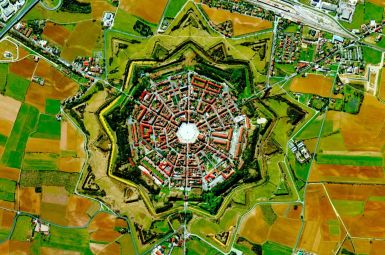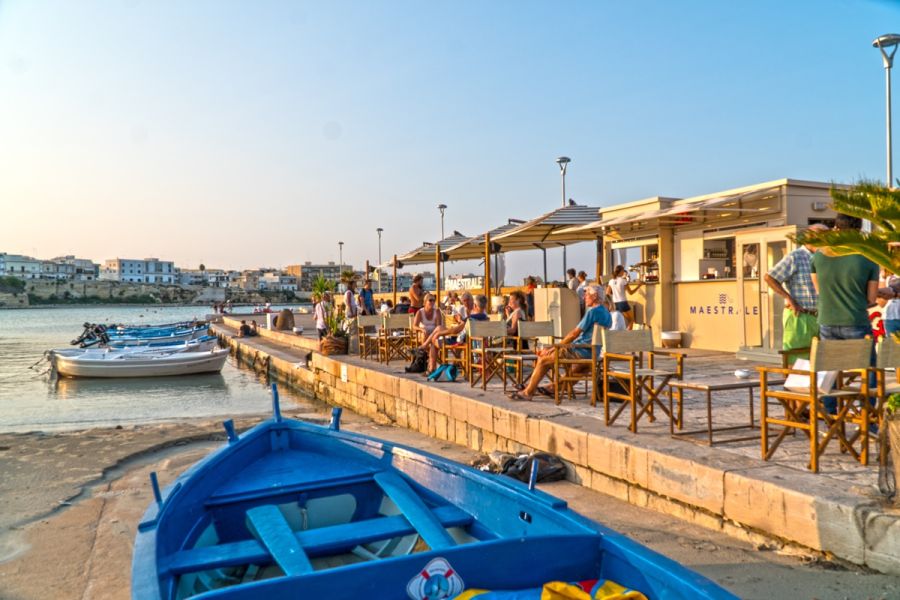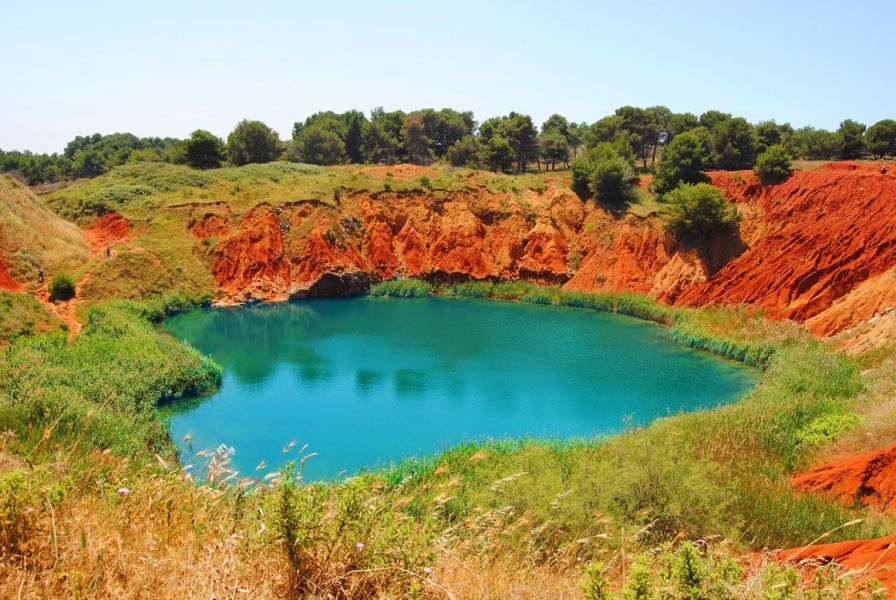
Il Borgo di Otranto

Il Borgo d’Italia
tutto da scoprire ed esplorare
Monumenti
La storia
La cerniera nella storia di Otranto è un punto fermo, nero e profondo come un pozzo, in cui la città è sprofondata per un anno. È il 1480, diciottomila uomini, soldati, centocinquanta navi, raggiungono il porto di Otranto; sono Ottomani, i più temibili tra gli aggressori delle terre bagnate dal mare. Attaccano senza pietà e il popolo idruntino resiste con coraggio e determinazione, fin quando stremati, distrutti nell’animo e nelle ossa, sono costretti a cedere la città ai turchi.
Per un anno questi barbari d’Oriente assediano la città, la scarnificano nel suo essere, distruggono la cultura e il suo simbolo: il Monastero Basiliano di San Nicola. Tra le sue mura era custodita la biblioteca più grande d’occidente ed era inoltre il primo College della storia che ospitava ragazzi da tutta Europa. I saraceni sul Monte Minerva uccidono ottocento uomini che avevano la sola colpa di non volersi convertire all’Islam. Non c’è umanità in questi diciottomila soldati, non scorre sangue caldo nelle loro vene. In soccorso di Otranto arrivano gli aragonesi, che riescono a cacciare via i turchi. La barbarie non vince su un popolo che aveva fatto del coraggio il suo vessillo: i martiri otrantini sono oggi Santi, i loro resti riposano nella cattedrale, e i volumi, salvati dall’incendio del convento, oggi sono conservati nei più importanti musei d’Europa, da Berlino a Mosca, passando per Londra. Le bombarde, palle di cannone in granito bianco con cui Otranto è stata attaccata dai turchi, sono visibili ancora oggi per il centro storico: cicatrici di una ferita su cui la città ha costruito una nuova vita.
La storia però di Otranto è anche altro: è il passato di un borgo che è diventato grande grazie al suo porto, che l’ha resa ponte tra oriente ed occidente. Nella sua cattedrale sono stati benedetti dodicimila crociati in partenza per la Terra Santa e dalla Terra Santa tornava San Francesco che nel 1219 approdò sulle coste idruntine, accolto con grandi onori.
Oggi Otranto è una delle città turistiche più importanti d’Italia, i segni del passato si distinguono ben nitidi nel suo centro storico ma anche fuori le mura. Il suo mare e il suo borgo antico lo rendono uno dei tesori del Salento e uno dei Patrimoni Mondiali dell’Unesco perché “ testimone di pace.”
Il Castello Aragonese
Il Castello di Otranto è stato costruito per volere di Alfonso d’Aragona, sul finire del 1400, e chiude l’anello di mura difensiva che per secoli ha protetto la città.
Dove oggi sorge questo imponente palazzo, c’era una struttura difensiva risalente al periodo svevo che ha ceduto sotto la pressione dell’invasione turca. Con gli aragonesi, che liberarono Otranto nel 1481, viene costruito un vero e proprio castello che aveva ed ha sempre avuto una funzione difensiva. Nella struttura sono state inglobate due torri cilindriche con cannoniere e successivamente una torre detta “punta di diamante”, il castello è stato circondato da un fossato che non ha mai avuto acqua, ma è servito solo a tenere lontani i nemici. Coloro che riuscivano ad intrufolarsi, finivano comunque vittima delle palle di cannone che venivano sparate in punti mirati, incrociandosi con le altre che provenivano dalle feritoie frontali, con una tecnica che si chiama “radente” e che impediva a chiunque di avvicinarsi.
Il castello di Otranto non è conosciuto solo per ragioni storiche, ma anche perché tra le sue stanze è ambientato il romanzo di Walpole “The Castle of Otranto”, che ricopre un ruolo cruciale nella letteratura mondiale, perché è stato scritto nel 1764 e di fatto è il primo romanzo gotico nella storia letteraria.
Il castello aragonese è nato come una struttura spartana, adatto ad ospitare guerrieri ed armi, oggi però è un centro di cultura ed accoglie nelle sue mura fortificate mostre ed eventi importanti.
La cattedrale
Sul punto più alto del borgo di Otranto è stata costruita la cattedrale dell’Annunziata, è tra le chiese più grandi della Puglia. È stata edificata su un luogo molto importante dal punto di vista storico, perché nello stesso punto si trovava una domus romana, un villaggio messapico e un tempio paleocristiano.
La Cattedrale di Otranto è stata costruita nel pieno del medioevo, tra il 1080 e il 1088, e tra le sue mura sono chiari i passaggi di diversi committenti che hanno arricchito l’edificio con decorazioni in stili diversi, ad iniziare dal barocco portale della facciata romanica in pietra leccese, sormontato da un rosone in stile gotico siciliano che risale all’epoca rinascimentale.
Gli interni sono suddivisi da due file di ampie colonne, che creano la navata centrale, la cui pavimentazione è ricoperta dal mosaico più grande d’Europa: l’albero della vita, ricco di misteriosi significati che portano ancora oggi ad Otranto numerosi studiosi.
Alla fine della navata centrale troviamo la Cappella Paladina, dove sono conservati i resti di seicento martiri d’Otranto. Le reliquie di altri duecento santi sono state traslate nella chiesa di Santa Caterina, a Formello, Napoli, dove si trova la cappella dedicata ai “Beati Antonio Primaldo e compagni martiri Idruntini”.
Alle spalle dell’altare maggiore è custodito il masso su cui vennero decapitati gli ottocento martiri, narra la leggenda che la prima vittima, Antonio Primaldo, rimase miracolosamente in piedi, senza testa, per tutta la durata delle esecuzioni.
Il soffitto è raro nella provincia di Lecce, in stile moresco, con cassettoni in legno dorati su sfondo bianco e nero.
L’intero impianto della cattedrale è sorretto da quarantadue colonne monolitiche che si trovano nella cripta, disposte in apparente disordine, appaiono come tronchi d’albero e sono legate al mosaico sovrastante, danno al visitatore un senso di smarrimento e allo stesso tempo rimandano allo stile arabo delle moschee.
Cava di Bauxite, Punta Palascia.
La (ex) cava di Bauxite si trova poco prima di giungere ad Otranto, immersa in uno scenario boschivo e sullo sfondo delle mille sfumature del mare. Sicuramente questo luogo si può collocare sul podio dei posti più fotografati del Salento.
Fino al 1976 da questa cava veniva estratta la bauxite, un minerale da cui si ricava l’alluminio. Dopo la fine dell’attività lavorativa, l’acqua della falda sotterranea si è insinuata nel sottosuolo andando a creare un laghetto color verde smeraldo, che contrasta con il rosso delle pareti rocciose e con il verdeggiare del bosco. Sicuramente la cava di Bauxite, oggi laghetto di Orte, è uno dei punti più suggestivi del Salento. Poco più avanti, lungo la provinciale, incontriamo il Faro di Punta Palascia, il punto più a Est d’Italia, dove oggi si può visitare anche il Museo del Mare.
Torre Sant’Emiliano, la Marmitta dei Giganti
Lungo il litorale costiero di Porto Badisco, si può ammirare Torre sant’Emiliano, a picco sul mare e bellissima nella solitudine paesaggistica che la circonda.
Vicino la torre si trovata una vera e propria rarità: una Marmitta dei Giganti. Si chiamano così le erosioni rocciose causate dall’acqua che formano delle vere e proprie scodelle naturali. Solitamente questo fenomeno si può ammirare vicino a torrenti e corsi d’acqua e raramente sulle zone costiere. In Salento se ne possono ammirare ben due: una nei pressi del ponte Ciolo e l’altra, appunto, vicino a Torre Sant’Emiliano. Proprio qui la natura si è impegnata veramente tanto perché insieme alla marmitta ha modellato un sasso che si trovava al centro e che col passare del tempo ha assunto una forma quasi perfetta, rendendo questo capolavoro bellissimo nella sua unicità.
I Laghi Alimini
Cambiando litorale, spostandoci verso Torre dell’Orso, incontriamo i Laghi Alimini che offrono un panorama mozzafiato e sono tra le aree protette della Regione Puglia.
I laghi Alimini sono due bacini di diverse dimensioni, “Alimini Grande” è d’acqua salata e ricoperto da una fascia di rocce e pinete, “Alimini Piccolo” chiamato anche “Le Fontanelle”, è alimentato da acque meteoriche e da alcune sorgenti. I due laghi sono collegati l’uno all’altra da un piccolo canale.
I Laghi Alimini proteggono un ecosistema di flora e fauna molto raro. Nelle loro vicinanze si trovano le orchidee di palude, la castagna d’acqua e l’erba vescica: una pianta carnivora che quando entra in contatto con un insetto apre le sue vesciche e lo inghiotte. Folaghe e Moriglioni vivono in questo stupendo habitat naturale.
Curiosità
Il mosaico di Otranto e la ricerca del Santo Graal
Nel 1163 iniziò la costruzione di quello che è considerato il mosaico più grande d’Europa e che merita un posto di prestigio nel podio dei mosaici più grandi del mondo. Venne costruito sotto la guida del monaco basiliano Pantalone. Raffigura un gigantesco Albero della Vita, sorretto da due elefanti, simbolo della forza cristiana. Nel mosaico sono raffigurate scene dell’antico testamento, con animali fantastici, segni zodiacali ma anche raffigurazioni di re Artù e scene di vita quotidiana.
È diviso in tre parti che coprono per intero la navata centrale e rappresentano allegoricamente la storia del genere umano. Il mosaico di Otranto è ricco di significati esoterici, su cui aleggiano miti e leggende. La più diffusa vorrebbe il mosaico idruntino come scrigno del Santo Graal. Il fatto che il capomastro era un monaco, che abbia descritto elementi del ciclo bretone e che lo stile e i temi non sono presenti in nessuna delle chiese vicine, supportano questa tesi. A ciò si deve aggiungere che i turchi scelsero la cattedrale come accampamento e che fu l’unico monumento a non essere distrutto o danneggiato. Erano forse anche loro alla ricerca del Santo Graal? Il mistero rimane custodito nella tomba del monaco Pantaleone.
La Grotta dei Cervi
È il 1970, cinque uomini scorgono tra gli anfratti della scogliera di Porto Badisco uno strano accumulo di pietre, decidono di spostarle ed entrano carponi in una serie di gallerie che conducono ad un’ampia sala interamente coperta di pittogrammi: è quella che oggi è conosciuta come “Grotta dei Cervi”.
In cinque giorni la grotta venne esplorata, fotografata e messa in sicurezza ma nessuno delle persone che entrarono in contatto con questo ambiente si resero conto di essere davanti ad uno più grandi monumenti pittorici di arte parietale post Paleolitica.
Una serie di cuniculi conducono alla grotta che è un vero tempio modellato sulle esigenze di chi ci è vissuto, con muretti a secco per proteggere dagli allagamenti, scalini scolpiti nella roccia tufacea e raffigurazioni dipinte con il rosso della terra e il nero del guano di pipistrello che ricopre il pavimento. Dettagliate scene di caccia ai cervi, si alternano a donne che danzano insieme a sciamani e a riunioni di capi tribù provenienti da terre lontane, ma anche umane figure stilizzate, zig zag e S ripetute un po’ ovunque.
Il gruppo di speleologi che la scoprì la ribattezzò “La Grotta di Enea” sulla base della leggenda che racconta dello sbarco dell’eroe troiano a Porto Badisco, ma quella in cui si trovavano era l’antica terra dei Cervi e da questi avrebbe poi preso il nome la grotta.
La grotta dei Cervi è uno dei gioielli del Salento ed è sicuramente tra i siti meno valorizzati e meno conosciuti, pericoloso e poco accessibile. Da più di quarantasette anni un’alta cancellata separa una parte di mondo rimasta ferma a più di cinquemila anni fa da un’altra parte in continuo movimento.
La leggenda del Castello
Ad ogni castello il suo fantasma e il maniero di Otranto non poteva certamente sottrarsi a questa “consuetudine”. Alcuni infatti giurano di aver visto una strana presenza aggirarsi sulla torre “punta di Diamante” e dentro le mura del castello: si tratterebbe dello spirito di Donna Teresa de Azevedo, nobildonna spagnola che morì in giovane età lasciando nello sconforto più totale il marito, allora regio di Otranto. In memoria della moglie quest’ultimo fece costruire nella cappella del castello un monumento sepolcrale in pietra leccese; sulla parete del piano superiore si trova un affresco con il ritratto di un aristocratico che si dice sia proprio il marito di Donna Teresa, che si è fatto raffigurare per poter vegliare sempre sulla moglie.
Il fantasma di Otranto ha catturato l’attenzione dell’Associazione Italiana Ricercatori del Mistero: nel 2014, con il permesso del sindaco, un’equipe si è recata nel castello aragonese dove le apparecchiature specializzate hanno registrato voci e rumori anomali e improvvisi sbalzi termici in determinati punti della stanza. Nonostante tutto però avendo a che fare con fenomeni paranormali i ricercatori che si sono recati sul posto preferiscono sempre rimanere cauti, e non sbilanciarsi con ipotesi azzardate.
Personaggi
Ennio Capasa
Nel 1960 a Otranto è nato Ennio Capasa, che dopo aver conseguito il diploma di liceo artistico a Lecce si trasferisce a Milano, dove prosegue gli studi all’Accademia di Brera. Intraprende una carriera da stilista tutta in ascesa e dal forte sapore internazionale: divisa tra Tokyo, Parigi e Milano.
Nel 1986 presenta la sua prima collezione CoSTUME NATIONAL. Nel 2005 collabora con Ducati e disegna una serie di accessori in serie limitata.
Attualmente vive a Milano.
Ettore d’Amore
Ettore d’Amore è stato un maresciallo dell’Arma dei Carabinieri. È stato insignito della medaglia al valor civile alla memoria per aver affrontato da solo un malvivente ed averlo messo in fuga, nonostante fosse stato ferito mortalmente.






























